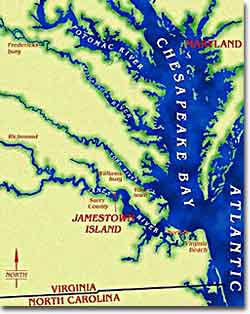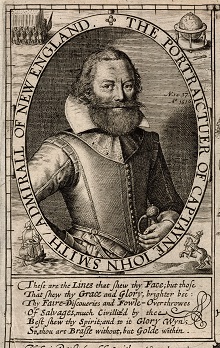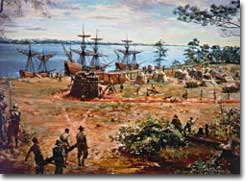2c. Jamestown Settlement and the "Starving Time"

Jamestown, Virginia, was the site of the first permanent English settlement in the Americas. The settlers chose a location close to the water, hoping to establish a thriving community.
The first joint-stock company to launch a lasting venture to the New World was the Virginia Company of London. The investors had one goal in mind: gold. They hoped to repeat the success of Spaniards who found gold in South America.
In 1607, 144 English men and boys established the Jamestown colony, named after King James I.
The colonists were told that if they did not generate any wealth, financial support for their efforts would end. Many of the men spent their days vainly searching for gold.
As a consequence, the colonists spent little time farming. Food supplies dwindled. Malaria and the harsh winter besieged the colonists, as well. After the first year, only 38 of the original 144 had survived.
First Virginia Charter
James, by the grace of God [King of England, Scotland, France, and Ireland, Defender of the Faith], etc.
Whereas our loving and weldisposed subjects ... and divers others of our loving subjects, have been humble sutors unto us that wee woulde vouchsafe unto them our licence to make habitacion, plantacion and to deduce a colonie of sondrie of our people into that parte of America commonly called Virginia, and other parts and territories in America either appartaining unto us or which are not nowe actuallie possessed by anie Christian prince or people, scituate, lying and being all along the sea coastes between fower and thirtie degrees of northerly latitude from the equinoctiall line and five and fortie degrees of the same latitude and in the maine lande betweene the same fower and thirtie and five and fourtie degrees, and the ilandes thereunto adjacente or within one hundred miles of the coaste thereof;
And to that ende, and for themore speedy accomplishemente of theire saide intended plantacion and habitacion there, are desirous to devide themselves into two severall colonies and companies, the one consisting of certaine Knightes, gentlemen, marchanntes and other adventurers of our cittie of London, and elsewhere, which are and from time to time shalbe joined unto them which doe desire to begin theire plantacions and habitacions in some fitt and conveniente place between fower and thirtie and one and fortie degrees of the said latitude all alongest the coaste of Virginia and coastes of America aforesaid and the other consisting of sondrie Knightes, gentlemen, merchanntes, and other adventurers of our citties of Bristoll and Exeter, and of our towne of Plymouthe, and of other places which doe joine themselves unto that colonie which doe desire to beginn theire plantacions and habitacions in some fitt and convenient place betweene eighte and thirtie degrees and five and fortie degrees of the saide latitude all alongst the saide coaste of Virginia and America as that coaste lieth;
Wee, greately commending and graciously accepting of theire desires to the furtherance of soe noble a worke which may, by the providence of Almightie God, hereafter tende to the glorie of His Divine Majestie in propagating of Christian religion to suche people as yet live in darkenesse and miserable ignorance of the true knoweledge and worshippe of God and may in tyme bring the infidels and salvages living in those parts to humane civilitie and to a setled and quiet govermente, doe by theise our lettres patents graciously accepte of and agree to theire humble and well intended desires;
April 10, 1606
"Work or Starve"
The colony may well have perished had it not been for the leadership of John Smith. He imposed strict discipline on the colonists. "Work or starve" was his motto, and each colonist was required to spend four hours per day farming.

The twenty of April. Being at work, in hewing down Trees, and setting Corn, an alarum caused us with all speed to take our arms, each expecting a new assault of the Savages: but understanding it a Boat under sail, our doubts were presently satisfied with the happy sight of Master Nelson, his many perils of extreme storms and tempests, his ship well as his company could testify, his care in sparing our provision was well: but the providence thereof, as also of our stones, Hatchets and other tools (only ours excepted) which of all the rest was most necessary: which might inforce us to thinke either a seditious traitor to our action, or a most unconscionable deceiver of our treasures.
– John Smith, "A True Relation of Occurrences and Accidents in Virginia" (1608)

An early advocate of tough love, John Smith is remembered for his strict leadership and for saving the settlement from starvation.
An accidental gunpowder burn forced Smith to return to England in 1609. After his departure, the colony endured even more hardships. A new boatload of colonists and supplies sank off the coast of Bermuda on its way to help the hungry settlement. The winter of 1609-10, known as the "starving time," may have been the worst of all.
Disease and hunger ravaged Jamestown. Two desperate colonists were tied to posts and left to starve as punishment for raiding the colonies' stores. One colonist even took to cannibalism, eating his own wife. The fate of the venture was precarious. Yet still more colonists arrived, and their numbers included women.

Pictured are the three ships that brought the original settlers to Jamestown in 1607: the Susan Constant, the Godspeed, and the Discovery.
Despite the introduction of tobacco cultivation, the colony was a failure as a financial venture. The king declared the Virginia Company bankrupt in 1624.
About 200,000 pounds were lost among the investors. The charter was thereby revoked, and Virginia became a royal colony, the first in America to be ruled by the Crown.
Investments in permanent settlements were risky indeed. The merchants and gentry paid with their pocketbooks. Many colonists paid with their lives. For every six colonists who ventured across the Atlantic, only one survived.







